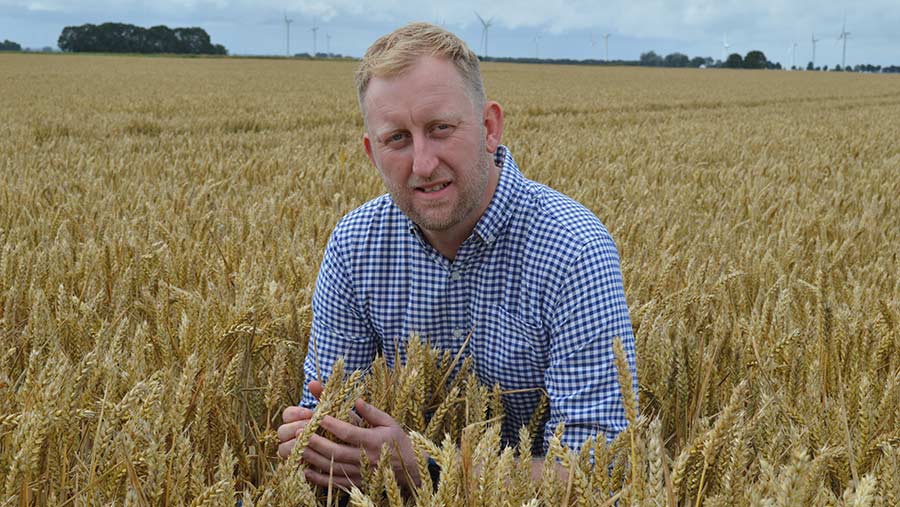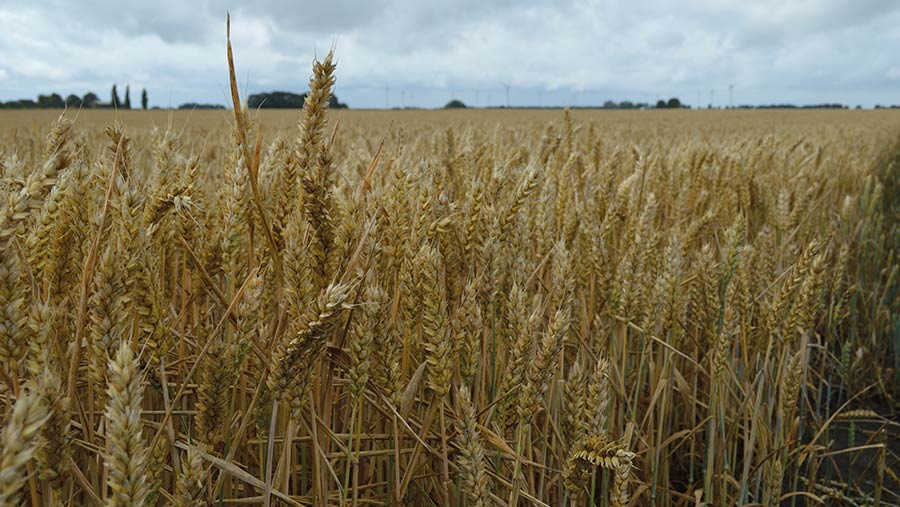Cambs farmer happy to grow wheat for breakfast market
 © MAG/David Jones
© MAG/David Jones Soft wheats have cemented their place in James Fountain’s rotation, earning a valuable premium from Weetabix, as well as fitting in with his strategy for controlling a troublesome grassweed.
The Cambridgeshire grower supplies 300-400t annually at a premium of £3/t over feed wheat – he has not had a load rejected in six years and it fits in well with his blackgrass battle.
He grows biscuit-making and soft-milling feed wheat varieties to supply the iconic maker of breakfast cereals, which focuses on sustainable production of wheat with a known providence.
See also: Weetabix feed wheat premiums can aid struggling profits
“Weetabix works for us with its price premium, early movement after harvest and pride seeing the end product,” he tells Farmers Weekly.
Late drilled
His winter wheats can be relatively late drilled from the end of October onwards to help control blackgrass, and this fits in well with his autumn harvest of potatoes and sugar beet on the farm.
He has grown for the company for six years, which coincided with a switch to focus on soft-milling Group 3 and Group 4 feed wheats away from hard-milling Group 4s to increase the marketability of his wheat.
“There are more local outlets for soft wheat in this area so it gives us more options to sell the wheat to Weetabix and other users,” he says.
Weetabix is supplied by about 350 farmers, all within 50 miles of its manufacturing plant at Burton Latimer on the edge of Kettering in Northamptonshire, with an annual requirement of about 75,000t.
Two traders
The supply of grain from farms is arranged by two big grain traders, Frontier and ADM, and Andrew Hill, national origination manager at Frontier, says there are two key conditions to meet the Weetabix protocol requirements.
The first is to be within 50 miles of the Burton Latimer mill and, second, supplying farms have to be in an environmental scheme – whether that is Linking Environment And Farming or a stewardship scheme to assure consumers that the wheat is produced in a sustainable way.
Breakfast cereal maker
Weetabix has had a chequered ownership history since production started at the Burton Latimer site in 1932.
The George family took over the company in 1947 and built it up to be the UK’s number-one breakfast cereal brand.
The company passed through the hands of two private equity groups from 2003 onwards, before China’s Bright Foods took a majority stake in the group in 2012.
Finally, the group was bought by Post Holdings in 2017, the third largest US breakfast cereal maker after Kellogg’s and General Mills, for £1.46bn.
Reducing the carbon footprint of its wheat growers is next on the agenda at Weetabix, as it looks to make its three plants at Burton Latimer, Corby and Manchester more environmentally friendly.
John Petre, supply chain and technical director at the group, says it is an obvious move to try to measure the growers’ carbon footprint and reduce it after looking at a similar carbon reduction approach at its three plants.
The group already cuts its food miles with its 50-mile radius protocol and its focus on sustainable agriculture, and will work in the future with grower groups to measure and try to reduce their carbon footprint.
Mr Petre adds that the company is not immediately looking for new growers and it has managed to source extra wheat from its existing growers, even with the boost in demand seen in the Covid-19 pandemic, with more consumers at home and eating breakfast.
He says the group is seeing steady growth helped by the trend towards healthier eating, with Weetabix containing 92% wheat and low levels of salt and sugar.
The specification is for a standard feed wheat of 72kg/hl specific weight, moisture of 15%, add-mixture below 2% and with lower mycotoxins, which can be a problem if wheat is grown after maize.
Jonni Henson, grain trader at Frontier, who is involved in the Weetabix relationship, says there is a fall back to 71kg/hl for specific weight in a year of poor grain fill.
Wheat area
Mr Fountain grows 200ha of winter wheat on the 450ha of arable land his family farms at Delavals Farm, as CJ Fountain & Son, near Whittlesey, just east of Peterborough, on a range of soils from fertile black fenland to silty clay loams.
He is growing 160ha of soft-milling Group 3 Firefly and Group 4 Elation and Saki, with the remainder made up of Extase on contracted land not in an environmental scheme.
The wheat fits well into his farming system, with potato harvest usually finished by the first week of October. Then he moves to winter barley drilling and the winter wheat usually is usually drilled between 20 October and 20 November.

© MAG/David Jones
Hybrid six-row winter barleys are grown for their suppression of blackgrass, while the delayed drilling of the winter wheats also helps control the grassweed, as does the four spring-sown crops of spring barley, mustard, potatoes and sugar beet grown on the farm.
Cultivations for the winter wheat crop are usually based around minimum tillage, with the plough only used after sugar beet, and seed rates tend to be on the high side at 200kg/ha to suppress blackgrass and allow for any slug losses.
Nitrogen rates
On his fertile land, nitrogen fertiliser rates can be as low as 130kg/ha, used in three splits, and up to 200kg/ha on poorer fields or when grown as a second cereal.
The three-way split consists of 50kg/ha in early March and the same dose again later that month, with the final dose of 30kg/ha put on in the third week of April.
Disease control is a comprehensive four-spray fungicide programme to keep on top of disease and Mr Fountain says Elation has become a “dirtier” variety and will be replaced by newer variety Prince next season.
He has noticed yellow rust in the Firefly, but is keen to stick with it as although the yield is not as higher as others, the quality is better. Saki is new to the farm this season and looked good.
“Saki has stood well this year and standing is key for wheats on our fertile soils,” he says.
Yields of the three wheat varieties this season have been about 8.5t/ha, just down on the farm’s medium-term average of 9t/ha, due largely to the lack of sunlight through the summer.
Specific weights for the Elation and the Saki were a respectable 74kg/hl, but the Firefly, which was harvested early than the other two, was a little lower.

